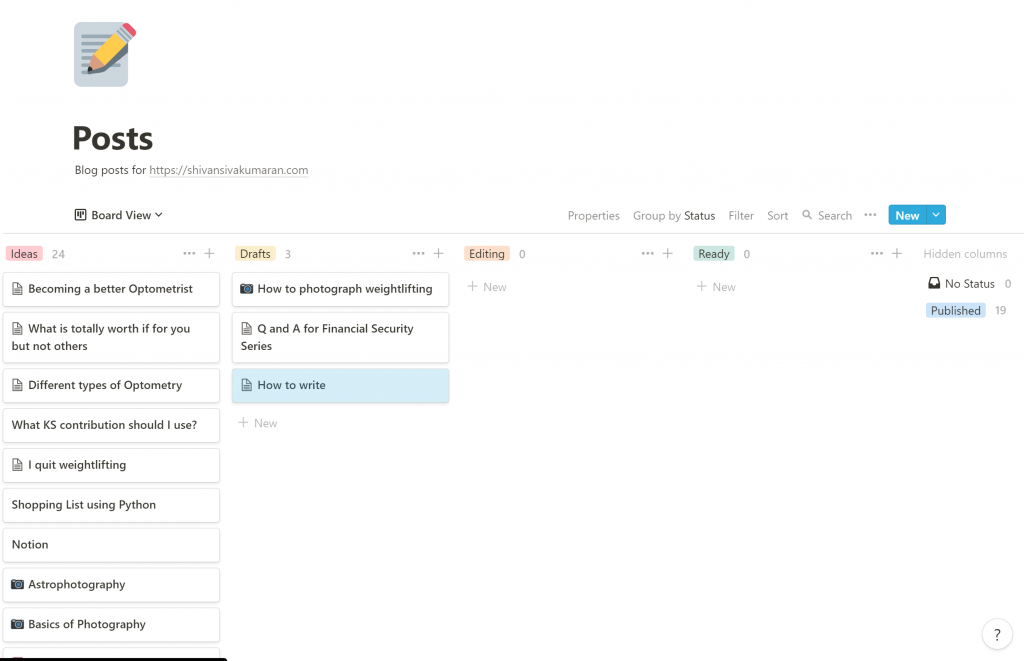Writing is a useful skill. Effective communication requires good writing. This benefits the readers but also benefits the writer in the long term.
To become better at writing can be challenging. Questions you might ask yourself are: why should I write? What can I write about? And how do I get unstuck when writing?
In this post, I will run you through the importance of writing, making it a habit, and some tools to keep you writing consistently.
Why Write?
Writing benefits the writer. It is a form of creative expression. Writing gets your ideas out to the world. It helps in your ability to tailor and present information to a particular audience.
Your writing contains expertise. To present this expertise to others, you must first understand their point of view. Then, your writing is tailored for this particular audience, making it easily read and engaging.
Writing builds the ability to process and explain information. This skill can carry over to other areas in your life. One example can be how you talk to others.
As you observe the world around you, you will become hungry for things to write about. You gain a new appreciation to what you see. Accountability to write becomes to next stage.
Create the Intention
Writing for a personal newsletter and blog is a useful platform to improve your writing. Being personal, you have freedom over how you write and what you write about.
Freedom can work with you but also against you. Without a deadline, will you produce writing regularly? Similarly, I’ve heard “the diet starts next Monday”.
Create a self-imposed deadline. One newsletter or blog per week. Or one a fortnight. Or a month. Unlike missing an assignment in school, if you miss one day, the sun will still rise. The world will not end. It’s okay. Life happens. Try and be consistent most of the time, not all the time.
The aim is to get something out there. It does not have to be perfect. By simply writing, over time you will improve and the benefits of writing will come, slowly.
Make a time in the day to sit down and write. And write free from distraction. I make this time one hour after I wake up well before work. Your best time will be up to you. This might involve some experimentation. I tried after work, during lunch. All attempts later and the morning seemed to stick.
Having a newsletter and a blog puts your idea in front of an audience, who may or may not be reading. Assume that they are. Don’t let it put you off. The way to get better is to be in front of a stage.
After you have created the intention to write, a problem you may face is coming up with ideas.
Where ever you go, your Ideas will follow

A notebook can be useful to capture ideas on the fly. Unfortunately, your ideas stay hidden when you sit down and think. They come usually at times you don’t intend.
In his book “Steal Like an Artist”, artist Austin Kleon gets his “best ideas when he is bored, which is why [he] never take[s] [his] shirt to the cleaners”. He would rather clean and iron his own shirts instead. For him, the act of performing this mundane task is like drinking from the well of creativity. For you, this might be time in the shower, when you drive, or before you fall asleep.
When an idea decides to reveal itself, don’t trust your memory. An exciting idea can linger for a few moments. It will disappear just as quickly as it appears. Later, when it’s time to recall this idea, it’s already gone.
This is why it is important to carry a notebook around with you most of the time. This allows you to capture any ideas when it is still fresh in your mind before it vanishes for almost ever.
Be reasonable though, writing in your notebook when you shower will just lead to wet pages. I’m also not advocating writing while driving, either. Usually, you ideas will still be in your head by the time you are done with your unrelieved activity. If you don’t think the idea will stick, then stop what you are doing safely and get it on paper.
Have Never-ending Ideas with the Kanban board
The Kanban board ensures you have an abundance of ideas to keep writing. Designed by the late Taiichi Ohno and implemented at the famous Japanese automotive manufacturer, Toyota, Kanban is a scheduling system that provides visual representation of stock in a manufacturing line.
Only you’re not manufacturing cars. You are writing instead. The Kanban board can facilitate turning your ideas into written pieces. Below is an example of how I use Notion (note that I have no affiliation with this company) to manufacture blog posts from ideas.

The Kanban board on the app, Notion. Here you can gain an insight into my writing process. Every blog post and every newsletter starts as an idea. All ideas that start life in my notebook get dumped into the aptly named ‘Ideas’ column.
On the morning of my writing, I pick one idea and turn it into a draft article. See the ‘Draft’ column. For that week, I focus on that draft, slowly chipping away at it.
Once the draft is complete, then it migrates to editing, where it is poked and prodded to something that is not perfect but reasonably good.
After, it graduates to the ‘Ready’ column, where it is ready to be published.
Finally, when it is published for the world to see, then it retires into the ‘Published’ section.
This is a simple workflow to keep the ideas coming that you could use. The next problem you face might be transforming that idea into a first draft.
Unblock your Writing
You have created the intention, made time to sit and write, and have a plethora of ideas. But when it comes down to putting words to paper, nothing comes out. How frustrating?
Understand you have two minds when you write: one is creative, the other is analytics. And the order you use them is really important: creative then analytical.
What happens when you swap the two around?
The analytical mind criticises every word before it is even written. It judges you into paralysis, acting as a dam that blocks your stream of thoughts. It manifests in our physical realm as the eraser or the backspace on your keyboard.
What we need to do is get the creative mind working first. We do this by putting “Fast Bad wRong” or “FBR” at the top of our page.
I got this idea from Ali Abdaal, who supposedly got this from another party. Simply put, when you write you want:
- Fast - Get you ideas down on paper or on screen quickly before you analytical mind has an opportunity to stop you.
- Bad - It’s going to be bad and that is okay. You can always make is less bad later on.
- wRong - It’s going to be wrong as well. Make it right once you have all your ideas out of your head and on paper.
What can also help is to block out distractions. Dedicate time to writing and writing only. Aim for just to sit down for 5 min. There will be some resistance in the beginning. After a while and almost my magic, you won’t be able to stop once the words start flowing.
After your first draft is complete, it is time to engage the analytical mind to improve what has been written.
Make you Writing Reasonable Good
You have written you draft, albeit horribly by your standard. Time to craft it into something that may not be perfect, but good enough.
When critically looking at your work, look it from four points: simplicity, clarity, elegance and evocativeness. I borrow this from Shaini Raja. Raja is an experience writer and I cannot do his writing course justice. However, we can use his framework to better our writing.
- Simplicity: is my writing simple? Sometimes we complicated our ideas with complex sentences and jargon. This can make you writing difficult to read. Try and clear up any long sentences to make your writing simple and easy to read. And use words that your audience will easily understand.
- Clarity: is my writing clear? Our ideas can be lost if what you writing is not clear. Make sure you ideas are obvious and make sense.
- Elegance and evocativeness: to me these go together. Ask yourself: is my writing pleasant to read and does not bore the reader, but it is not over complicated either.
Remember we are pushing for excellence and not perfection. Do the best you can. You will naturally get better the more you publish.
Conclusion
Writing is the expression of one’s ideas. Working on your writing has many benefit to you. This can be improving your ability to craft ideas and being able to communicate this to others.
Writing can be difficult to improve. Blogging and writing newsletters giving you a stage to perform on.
Capturing your ideas safely using a notebook and transferring them onto a Kanban board can ensure you have many ideas to write about.
Next we think Fast, Bad, wRong, engaging the creative mind to get ideas on to paper without judgement.
Afterwards, the analytical mind takes over to sculpt what has been written, something that reasonable good enough to push out to the world.
As a final word, I hope this helps you on your journey of writing or creating. Good luck and I wish you the best!
